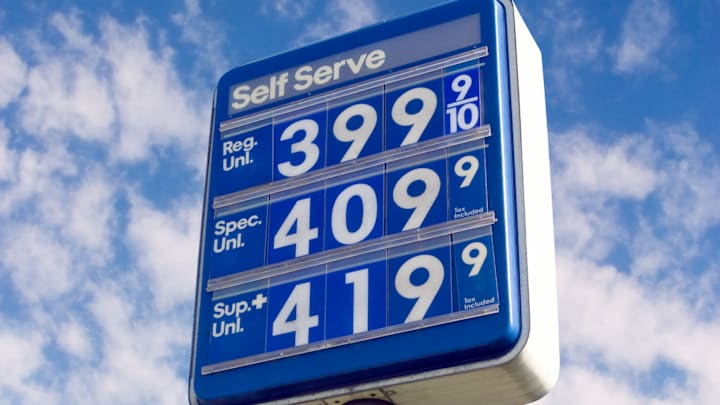Gas prices are rarely a place to find good news, particularly with credit card surcharges and steadily rising prices. But regardless of whether the price is low or high, you’ve probably noticed that gas stations always tack on a peculiar charge to their listed cost. It’s 9/10 of a cent. What’s with this penny fraction?
Blame the government and the Great Depression. The Revenue Tax Act of 1932 allowed for a federal tax of $0.01 to be placed on gas prices to help offset the national debt. Because gas was priced in pennies in those days, a fraction of a cent was considered reasonable—rounding up would have meant tacking on a massive surcharge. If filling up your tank cost 10 cents, and you had to pay another full cent instead of only a fraction, well, you’d be hopping mad about it.
“What in tarnation,” you might say. “Gas at 11 cents! Why, it’s only 10 and 4/10 cents down the road!” And then you’d drive down to the next gas station without a seat belt to reap the savings.
Gas station owners weren’t about to give up their business by rounding up, so they instituted the percentage of a cent to keep prices down. By the 1970s, 9/10 became the standard, as consumers were annoyed by fractional price fluctuations mandated by the government.
Federal and state gas tax is still a fraction of a penny. Gas stations can’t round down because their profit margins on gas are slim enough as it is. By one estimate, gas stations make only five cents per gallon in profit, so lopping off a cent is like giving away 20 percent of sales. Extrapolate to the entire fuel industry and that funny little fraction is raking in hundreds of millions in revenue.
So why not round up on the sign? After all, paying $3 or more a gallon means drivers are no longer going to be too worried about paying an extra 1/10 of a cent. But marketing has proven that consumers tend to perceive prices as being lower when they end in “9” since they don’t necessarily round up in their heads. So gas costing $2.29 and 9/10 looks more appealing than gas costing $2.30. But the total always gets rounded up, so what you see and what you pay are usually two different things.
One brave dissenter did try to fight the system. In 2006, Jim Davis, owner of Jim’s Texaco, experimented with gas at $2.99 a gallon instead of $2.99 and 9/10. No one cared, and Davis lost $23 a day in revenue. If someone noticed at all, they assumed gas was really $2.98 and 9/10 and he was just rounding up. Fractional gas pricing is probably here to stay. Nice try, Jim.
[h/t Gizmodo]
A version of this story originally ran in 2021; it has been updated for 2023.
